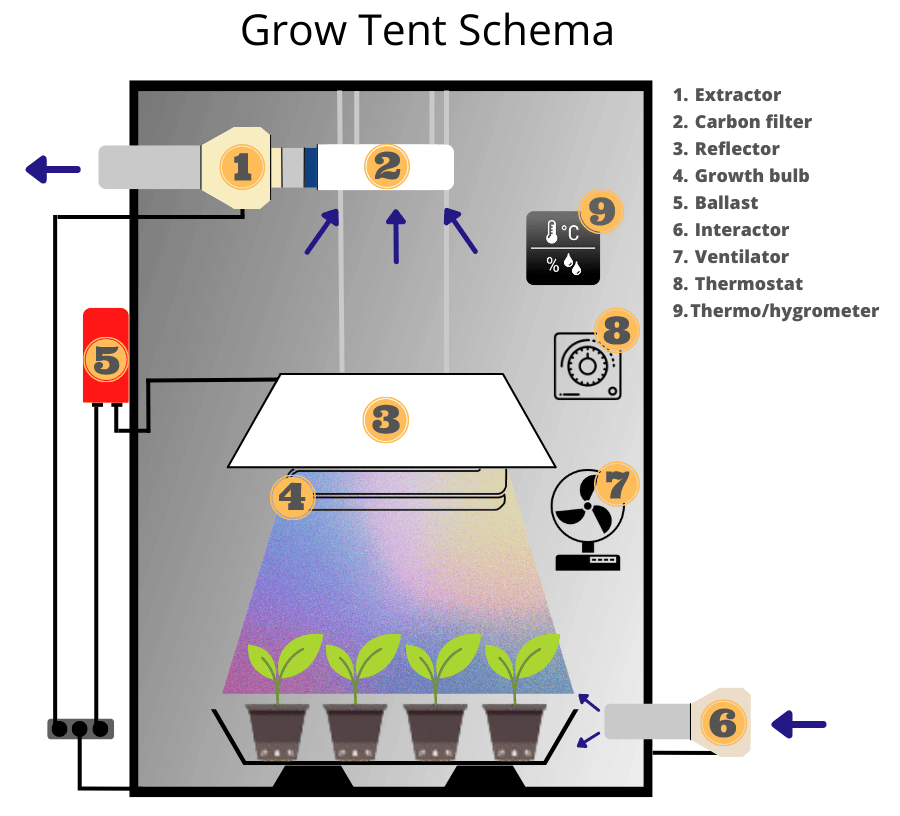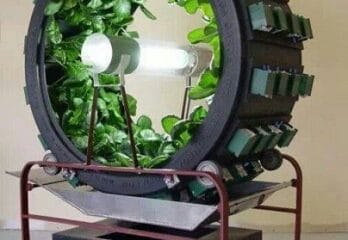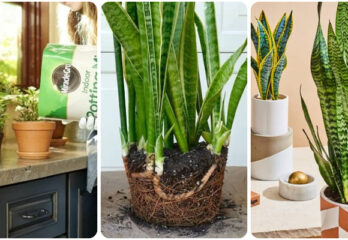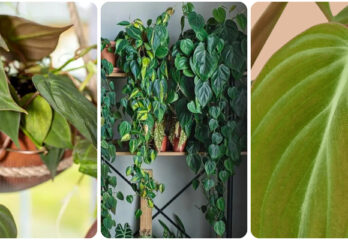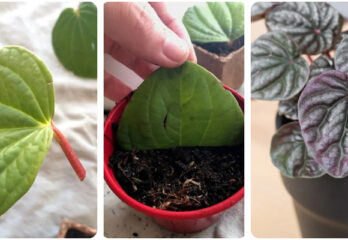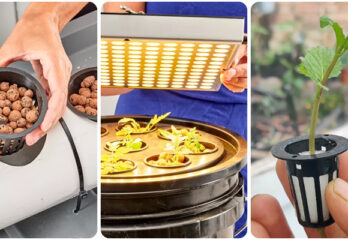This article is the ultimate guide for beginners looking to build their own hydroponic garden. If you don’t have enough space for a traditional garden, consider growing indoor plants hydroponically, including vegetables, herbs, and houseplants.
This guide will provide a quick overview of the process and help you get started growing hydroponic plants as quickly and easily as possible.
 Before you start growing hydroponics herbs, veggies, and leafy greens, you’ll need to pick the right system to start with. Here are our suggestions: Our Picks for the 5 Hydroponic Towers, Picks for the 5 Best Aeroponics Systems with Buyer’s Guides and Our Picks for the 5 Grow Tent Kits with Buyer’s Guides.
Before you start growing hydroponics herbs, veggies, and leafy greens, you’ll need to pick the right system to start with. Here are our suggestions: Our Picks for the 5 Hydroponic Towers, Picks for the 5 Best Aeroponics Systems with Buyer’s Guides and Our Picks for the 5 Grow Tent Kits with Buyer’s Guides.

What Are Hydroponic Plants?
Hydroponics, a type of gardening that doesn’t require soil, grows plants in a solution containing water and nutrients. Hydroponic systems are able to grow vegetables and plants faster than those grown outdoors in soil. They can also be used all year.
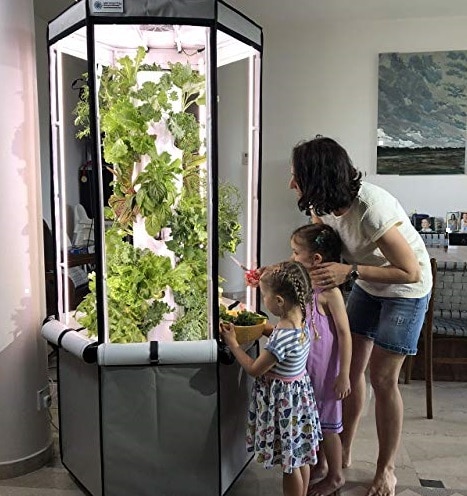 Aerospring 27-Plant Vertical Hydroponics Indoor Growing System
Aerospring 27-Plant Vertical Hydroponics Indoor Growing System
- Easy to use aeroponic system for your home
- Fan - Grow Lettuce, Herbs, Veggies & Fruits
- Grow smart & eat healthy, 20 gallon water reservoir Grow Tent, LED Grow Lights
Hydroponically grown plants often produce more, use less water, and require less space than conventional gardening. Hydroponic systems can also be a great solution for urbanites and apartment dwellers who don’t have an outdoor garden plot.
In my opinion, for beginners starting hydroponic gardening, there are four systems that can be used: water culture, wick, ebb, and flow. Advanced systems include the nutrient-film technique and aeroponics system.
What Plants are Possible to Grow Using Hydroponics
There are various plants that can be grown in a water-based medium, including those commonly found in outdoor gardens. These plants can come in different sizes, ranging from smaller to more compact varieties. Regardless of the size of your garden, it can thrive as long as it receives sufficient light and nutrients. Some gardeners may struggle with this concept as they believe that soil is necessary for plant growth.
Start with greens such as lettuce, spinach, and Swiss chard; herbs like basil and oregano; fruiting plants such as tomatoes, strawberries, and hot peppers; and herbs like mint, parsley, and cilantro.
I think that, Clay pebbles are a good choice for supporting larger plants such as tomatoes. They allow the roots to hold onto something and give them support. Below is a list of vegetable plants that can be grown hydroponically.
Hydroponic Plants That Grow Quickly
Hydroponic systems that grow plants without soil speed up plant growth. They bring nutrients directly to the plants so that they don’t need to develop large root systems in order to find food.
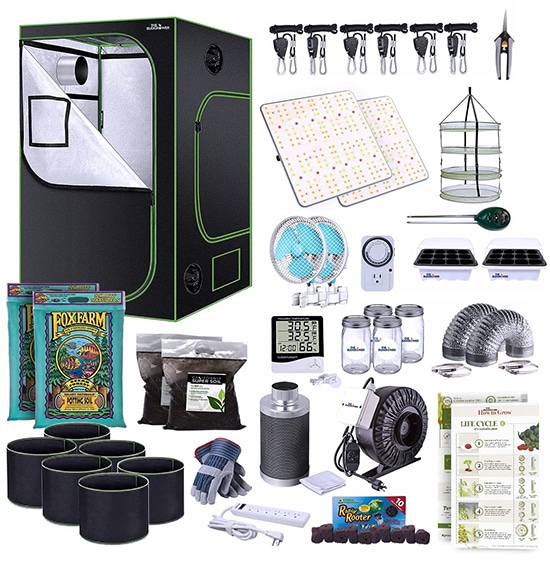 TheBudGrower Complete All-in-One Home Grow Solution 4x4x7ft- 2200W(2)
TheBudGrower Complete All-in-One Home Grow Solution 4x4x7ft- 2200W(2)
- LED lights specialty manufactured by VIVOSUN with Samsung LM301 diodes for FULL spectrum light
- The industries most durable grow tent – heavy duty 1680d oxford cloth
- Money & energy saving complete home grow tent kit
These conditions will make plants grow faster, but not all plants. Some plants can be harvested in as little as a week. Hydroponics is a great way to learn. You can try out different plants to find the best ones.
- Coriander
- Basil
- Blueberries
- Strawberries
- Spinach
- Peppers
- Spring Onion
- Cucumber
- Lettuce
Coriander is one of the most beautiful herbs you can grow. It takes only four weeks for it to produce two or three harvests. If you want to harvest great herbs, all you have to do is give them lots of light.
Coriander is loved for its many benefits, including providing protein, vitamin K and vitamin C.
Basil is another herb you can grow. They don’t require much care, but they can still produce impressive crops. Basil has many health benefits, including aroma, taste, and other health benefits.
A study has actually shown that eating basil can reduce inflammation and swelling. Basil is high in antioxidants that can protect against free radicals, which are a major cause of premature aging.
Blueberries require acidic soil conditions. This is why hydroponic conditions are best for them. This is because the berries need to be controlled in terms of their PH and nutrients to grow bigger and healthier.
This fruit is high in antioxidants, so it can protect your brain and nervous system. Blueberries are actually ranked among the fruits with the most vitamins and antioxidants needed by the body.
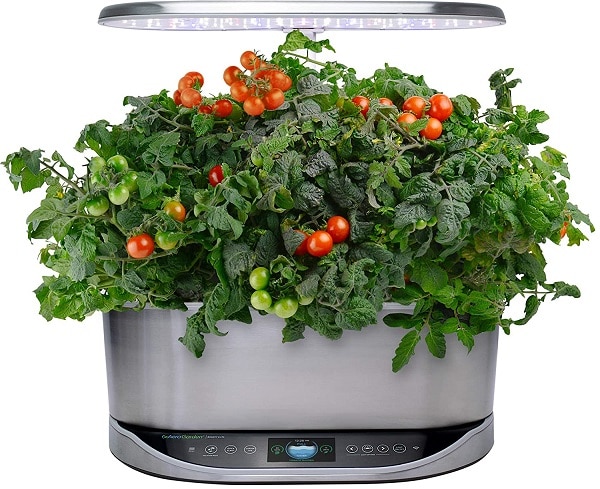 AeroGarden Bounty Elite - Indoor Garden with LED Grow Light
AeroGarden Bounty Elite - Indoor Garden with LED Grow Light
- WiFi and Alexa Compatible, Stainless Steel Grow up to 9 plants, up to 24duim
- Includes everything you need to grow
- 50 watt LED Grow Lights, perfect spectrum for fast growth & big harvests
What are the Most Common Problems That Hydroponic Plants Face?
From my experience it follows these are some of the most common problems you might encounter. This information should help you avoid making mistakes and equip you with the necessary knowledge to deal with other situations.
1. Leasks in a hydroponics system can happen for many reasons.
Any joint or valve in your system can leak. Leaks can also happen if your system becomes blocked. For example, a root mass can block an NFT system. This will cause water to back up and overflow. If you have a system that has a smaller reservoir than the one required to hold the entire nutrient solution, leaks may also be possible. This could lead to back-up and overflow in your reservoir due to a power outage or pump failure.
2. Shopping for cheap, insufficient, or incorrect lighting.
My hydroponics system is best used indoors, so I can grow fresh vegetables throughout the year. The performance of any system is very poor if it doesn’t have the right lighting.
3. Using the wrong fertilizer.
A lot of micronutrients required for growing plants in soil are already present in the soil. To ensure healthy plant growth, fertilizers designed for soil plants do not need to contain many trace micronutrients.
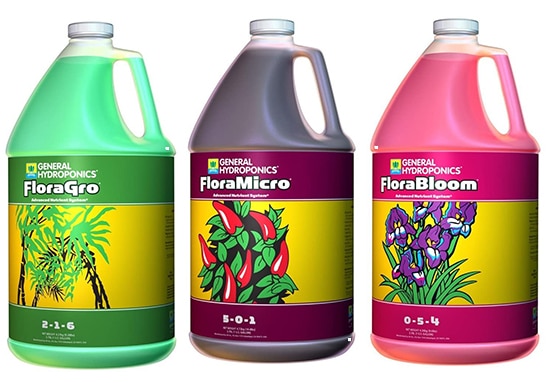 General Hydroponics Flora Grow, Bloom, Micro Combo Fertilizer, 1 gallon (Pack of 3)
General Hydroponics Flora Grow, Bloom, Micro Combo Fertilizer, 1 gallon (Pack of 3)
- Сomplete nutrient system
- Highly purified concentrates for maximum solubility
- NASAAntarctic research scientists choose flora series!
4. You don’t keep things clean.
Allowing your hydroponic system to become messy can increase the risk of pest and disease infestations. Proper cleaning is crucial to prevent the growth of algae and the spread of pests and diseases in your setup.
5. You are not monitoring the health of your plants.
You will miss signs of trouble if you don’t monitor your plants often. This could be insufficient growth, signs of disease, or deficiency. The sooner you notice a problem, you can fix it without destroying your plants.
6. Use of hard water in your hydroponics system.
Hydroponics systems can be affected by hard water, as we have already mentioned. You should be able to use your water below 200 PPM. However, tap water with high levels of total dissolved solids can cause problems with your nutrient solution.
7. Choose the wrong growing medium.
There are so many options when it comes to growing media. If you are interested in learning more about choosing the best growing media, I have an entire article on it. While some growing media can be reused, others are only good for one use. Some media are absorbent and will retain water around the roots of your plants.
What is the Time It Takes to Grow Plants Hydroponically?
Some leaves can be ready in as little as three weeks. Lettuce (Iceberg or other head lettuce) – These vegetables have a longer soil growth time, but they still thrive in a hydroponics system. They should be ready within six to eight weeks.
Vegetables can live the same life span whether they are grown in soil, or hydroponically. Hydroponic gardening allows for light exposure 24 hours a day, so there are no nighttime or cloudiness periods. thereby allowing for longer periods of growth.
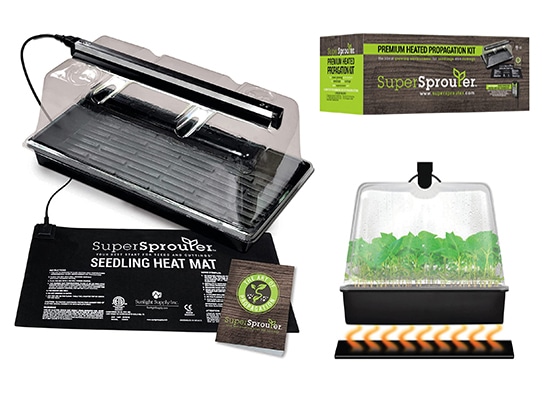 Super Sprouter Premium Propagation Kit with Heat Mat, 10
Super Sprouter Premium Propagation Kit with Heat Mat, 10
- Dome & T5 Light, 5 Piece, Black/Clear
- Art of Propagation booklet with expert advice for starting seedlings and cuttings
- Super Sprouter Seedling Heat Mat 10 in x 21 in is ETL listed
Plant pests and diseases can also be controlled, which reduces stress.
Hydroponically grown vegetables can grow faster and thicker than those grown in the soil if they are given enough light.
How Do I Start a Hydroponic Plant?

Many people avoid starting their own seeds due to the effort and time involved. However, there are many great reasons to hydroponically start your seeds. It is so much simpler to go to the grocery store and pick up seedlings that you can put into your system to start growing. However, buying seedlings from the store can have its downsides. You can avoid these by starting your own.
First, you are limited in what you can grow within your system. The store will only give you a limited selection. You can still grow almost anything if you plant your own seeds. This allows you to grow your favorite heirlooms and rare plants that aren’t available at most nurseries.
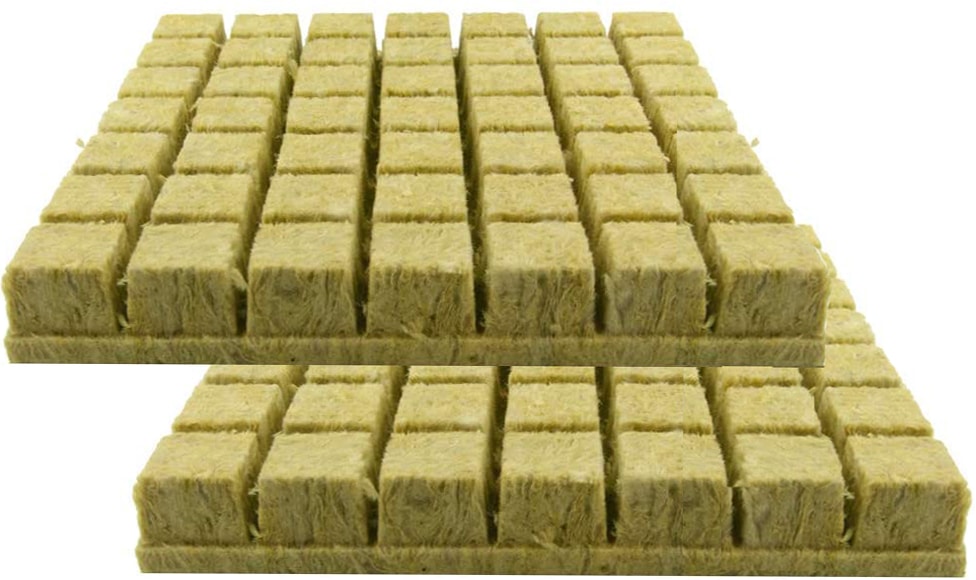 1.5 Rockwool Starter Plugs, 2 Sheets of 49 Plugs (98 Plugs Total)
1.5 Rockwool Starter Plugs, 2 Sheets of 49 Plugs (98 Plugs Total)
- 2 Sheets of 49 Plugs (98 Plugs Total)
- Twin Canaries Chart
- Capacity for absorbing nutrient solution, retaining plenty of oxygen
How to Choose Plants and Start Your Seeds
By adding seeds to your hydroponic systems, they won’t suffer any root trauma from being transplanted. You could also get bugs or diseases from this process.
To create a perfect environment, you can use a small greenhouse-like grow tray that has a dome. A heating mat can be used underneath a grow tray to heat it. This is essential for seeds to sprout. It is important to have light as it will encourage your seeds to sprout.
Choose Your Hydroponic System, we recommend this article about the hydroponic bucket systems!
There are six types of hydroponics systems. These are:
- Deep Water Culture (DWC).
- Ebb and flow (Flood & Drain)
- Wicking
- Drip
- Aeroponics
- Nutrient Film Technique (NFT).
There are many variations of each type of hydro system, but these are just the basic overviews.
Here’s what you need to know:
All these systems are hydroponics, as they don’t require soil and you feed the plants with a nutrient-rich water solution rather than planting them in soil. There is only one difference between these systems: how they deliver water, oxygen, and nutrients to the plants.
Choose a Light Source
Your plants require light to grow.
Simply put, if your hydroponics system is located where your plants get at least 6 hours of sunshine per day, then that is the best. The sun provides the perfect lighting for your plants to grow properly.
If your plants are not able to be found in direct sunlight, you’ll need to use artificial lighting with your indoor grow lights.
High-intensity discharge lights are the best lighting for hydroponics systems. They can be high-pressure sodium bulbs or metal halide lamps. The orange-red light from halide bulbs is ideal for plants at the vegetative stage.
Another type of lighting that is used in hydroponic grow areas is the T5. This fluorescent light produces high output and is low in heat. It is great for cutting plants and plants that have short growth cycles.
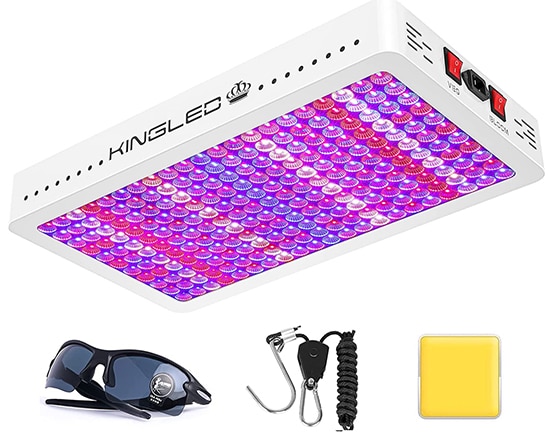 KingLED Newest 3000w LED Grow Lights with LM301B LEDs and 10x Optical Condenser 6x6 ft
KingLED Newest 3000w LED Grow Lights with LM301B LEDs and 10x Optical Condenser 6x6 ft
- Coverage Full Spectrum Grow Lights
- For Indoor Hydroponic Plants Veg Bloom
- 3 years Professional Service and free return for 90 days
Select A Hydroponic Grow Medium
Three acronyms are important to remember when choosing a medium: WHC (AFP), and CEC.
WHC is Water Holding Capacity. It indicates the media’s ability to hold water.
It is vital to know the WHC of your growing medium. Some hydroponic systems are more compatible with lower WHCs, while others will work better with higher WHCs.
High WHC environments for plants like coconut fiber are a great choice for wick systems, as they keep nutrients accessible and do not require excessive watering.
NFT (nutrient film technique) systems, on the other hand, benefit from lower WHC environments like clay pebbles because the roots of the plants are continuously exposed to the nutrient solution. They use the medium more for support than for saturation.
AFP stands for Air Filled Porous. It refers to airflow in the medium.
A low AFP indicates that the medium isn’t providing oxygen to the plants well. This can lead to them being at risk of drowning or rotting.
CEC, also known as Cation Exchange Capacity or Cation Exchange Capacity. It indicates the number of minerals in the growing environment.
A low CEC is a good choice for hydroponic systems because it allows you to better manage the nutrients that your plants get.
Coconut fiber is one example of a medium that has a high CEC and may need a nutrient solution to ensure the right balance.
The most common growing media for hydroponics systems are perlite, lightweight expanded clay aggregate, and coconut fiber.
Hydroponic Nutrients and Supplements
Hydroponic systems can use both dry and liquid forms of nutrients (or fertilizers). They also come in organic and synthetic varieties. Hydroponic gardening requires specific fertilizers. The main macronutrients of fertilizer–nitrogen and potassium, phosphorus and calcium–and the micronutrients iron manganese and zinc should be present.
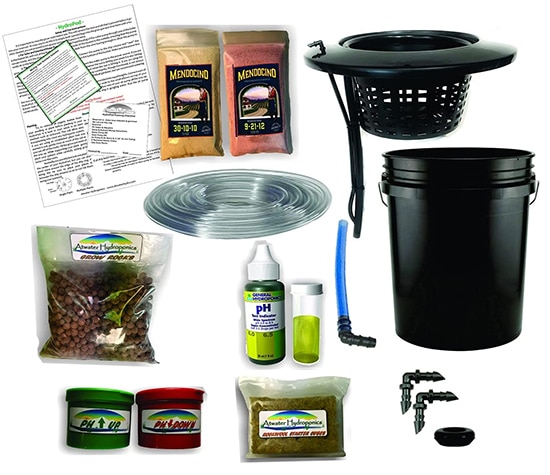 The Atwater HydroPod - Standard A/C Powered DWC/Recirculating Drip Hydroponic Garden System Kit
The Atwater HydroPod - Standard A/C Powered DWC/Recirculating Drip Hydroponic Garden System Kit
- Most efficient use of water compared to traditional gardening
- Dual outlet air pump, Nutrients are Included!
- Kit contains everything you need to start your own garden (minus plants and water!)
Buy a pH Meter and pH Up/Down
You should also know the importance of pH if RO water is used and tap water. Tap water tends to be between 7.0 and 8.0 pH. This guide recommends water with a pH of around 5.5 to 6.3, which is the “sweet spot”.
How can you tell? To test your water, you will need a pH tester. To adjust pH levels, you can add pH-Up to your water.
This is why it is so important. This is because if the pH of your hydroponics system is out of balance, your plants will not absorb any macro, secondary, or micronutrients as well as vitamins, carbohydrates, and other beneficial nutrients. It can happen quickly if there isn’t a stabilizing agent or mechanism,
It is a hassle to deal with pH issues. This is the bad news. The good news is that you can eliminate any pH problems completely with the right products.
BONUS: How to Transplant Hydroponic Plants
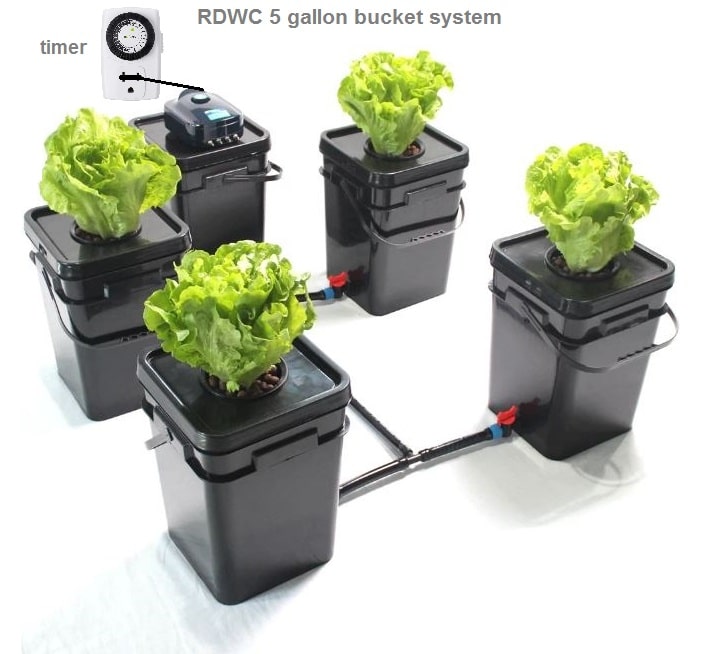
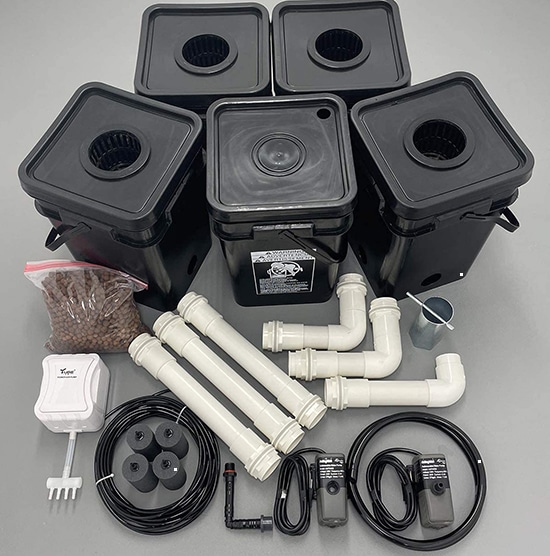 Recirculating Deep Water Culture (RDWC) Hydroponic Grow Kit System
Recirculating Deep Water Culture (RDWC) Hydroponic Grow Kit System
- Reservoir Bucket Connected to 4 Grow Buckets
- 400 Gallon/hour Circulating Pump
- Large 5 gallon square buckets, pre-drilled
Hydroponic nutrient solutions will keep your seedlings strong and healthy. You don’t need to reduce the strength of your nutrient solution once they have grown.
The roots of your seedlings will start to emerge from the bottom of the cube. This is the signal you have been waiting for. Depending on the plants you are growing, this can take between two and four weeks.
Place the starter cube in your hydroponics system’s growing medium for the seedling. Place the starter cube in your growing media and cover it with a gentle cloth.
Water your root system for a few days so it can naturally search out the nutrients and water.
Here you go! You have successfully grown your own seedlings to add a strong plant to your hydroponic system.

Conclusion
Growing hydroponic plants has many advantages. You can get more harvest with fewer resources. They require less space and water. This is an excellent way of growing plants if you live in a city and don’t have a special dedicated place to grow your plants like a garden.
Even for those who have a garden, hydroponics can be a great solution to get more harvest with fewer resources spent.
However, before starting to grow plants with this method, you need to know how to do it properly. This will help you avoid the most common mistakes.
Hopefully, this ultimate guide on how to grow hydroponic plants will help you get the best results.
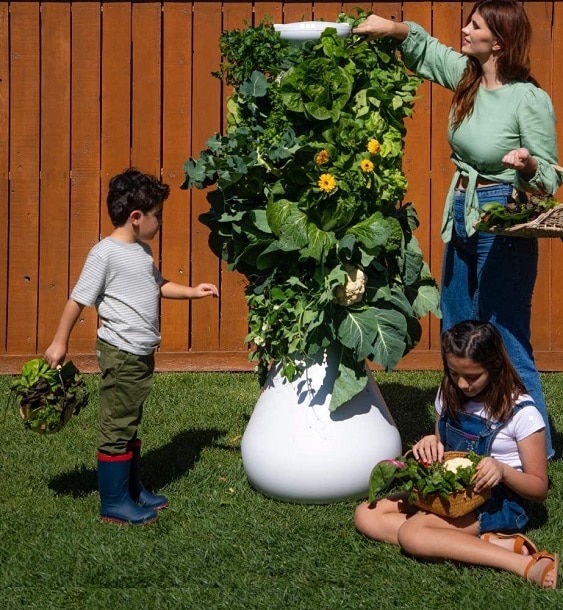 Lettuce Grow 36-Plant Hydroponic Growing System Kit
Lettuce Grow 36-Plant Hydroponic Growing System Kit
- Large Home Organic Gardening with Self Watering with Pump, BPA Free and Food Grade
- Outdoor Indoor Vertical Garden Herb Vegetable Planter Tower
- All the gear: farmstand tower, water pump, power cord, timer; and Nutrients for 130+ Plants
FAQ
Are hydroponic plants safe?
It all depends on what nutrient solution is used to grow the vegetables. However, hydroponically grown vegetables may be as nutritious as vegetables grown in soil. Because plants make their own vitamins and so the vitamin levels of vegetables grown hydroponically and soil are similar.
Are hydroponic plants able to grow in direct sunlight?
Hydroponics requires light, but not sunlight. Hydroponics can be grown outdoors or indoors in a greenhouse. Your plants will receive all the natural light they require. If you have enough natural light, indoor space is also possible.
Which plant is easiest to grow hydroponically
Try these easy-to-grow plants if this is your first venture into hydroponic gardening.
- Lettuce. Along with other greens like spinach, kale, and others, this is the most commonly grown vegetable in hydroponics.
- Tomatoes
- Hot Peppers
- Cucumbers
- Green Beans
- Basil
- Strawberries.
How can you care for a hydroponic garden?
You should drain, clean, and refill the nutrient solution (fertilizer or water) at least once a month. Hydroponically grown plants don't require soil. This means that there is no need for soil-borne diseases and pests.
Why are my hydroponics plants dying?
Your plants are almost completely dependent on a nutrient solution. Your plants can die if the nutrient solution is too acidic or alkaline. A hydroponic system with an unbalanced pH level can lead to plant death.
How can you fix hydroponics that is drooping?
An air stone or pump can be added to your system to help with leaf droop. Alter your plant so that half of it is exposed to the air and half are in the nutrient solution.
Hydroponics root rot: How can you get rid of it?
How to save a hydroponic plant from root rot
- Your hydroponic system should be turned off.
- To get rid of debris and dead roots, run the roots underwater.
- Drain the nutrient solution out of your reservoir.
- Next, you need to get your system up and running again.
How can you prevent fungus from hydroponics?
How to reduce mold risk in your hydroponics system
- Hydroponic equipment should be sterilized regularly.
- Reduce humidity by taking steps.
- Airflow is important for plants. Don't overcrowd them and trim them when necessary.
- Take as few of the plant's open parts as possible when taking cuttings.
How can you stop the growth of algae in hydroponics systems?
The easiest way to reduce the amount of algae in your system is to shade it. To grow and multiply, green algae requires sunlight. Thus, if you shade your hydroponic system for a while, it can help.

 Recirculating Deep Water Culture (RDWC) Hydroponic Grow Kit System
Recirculating Deep Water Culture (RDWC) Hydroponic Grow Kit System
- Reservoir Bucket Connected to 4 Grow Buckets
- 400 Gallon/hour Circulating Pump
- Large 5 gallon square buckets, pre-drilled
